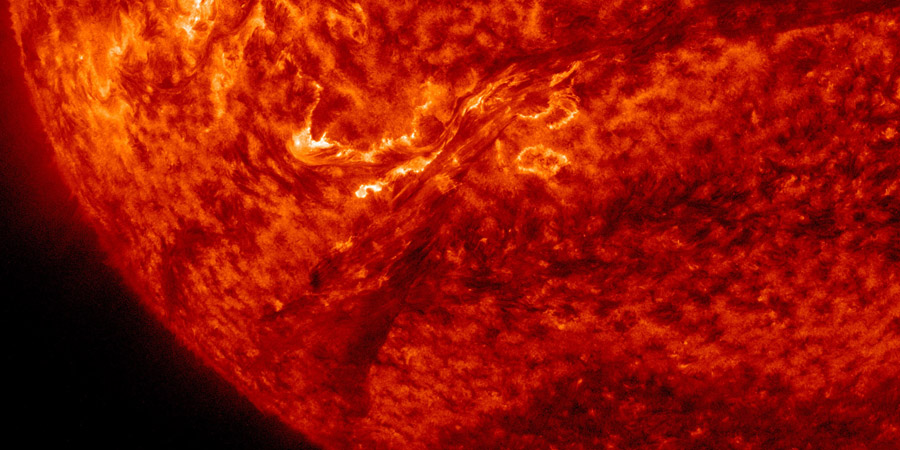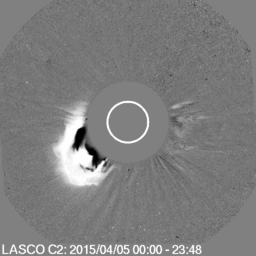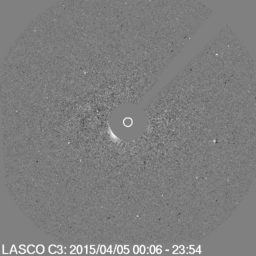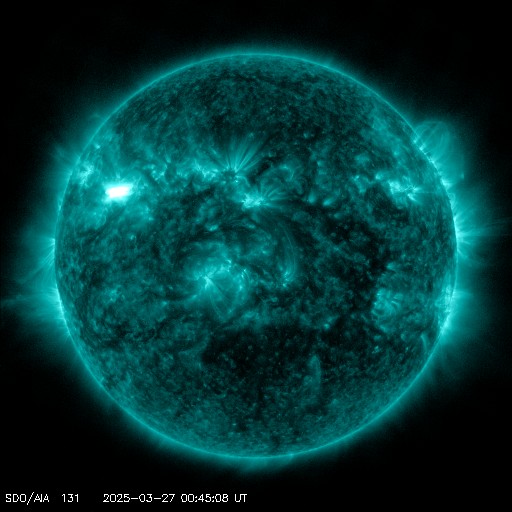Filament eruption
Sunday, 5 April 2015 13:18 UTC

As Saturday turned into Sunday, the easternmost part of the large filament channel that was facing Earth erupted and launched a coronal mass ejection into space. The big question is: does this eruption have an earth-directed component?
First things first: solar activity remains low with no sunspot regions on the disk which could produce a strong solar flare. In fact, this filament eruption was associated with the largest X-ray event of the past 24 hours. A C3 hyderflare followed after the filament disappeared. Based on imagery from SDO we could conclude right away that most of the material would travel to the south-east and miss Earth, something that SOHO confirms. Coronagraph imagery from SOHO shows that the coronal mass ejection does expand to form a partial halo of more than 180 degrees but the halo does not expand to form a full halo meaning we will see a glancing blow from this coronal mass ejection at best. Based on the speed of the eruption which is estimated to be around 700km/s we can conclude that a glancing blow is possible late on Tuesday or perhaps early on Wednesday. We do have to note that only a very minor part could have an earth-directed component and this shock passage will likely not be strong enough for a geomagnetic storm.


Images: Coronagraph imagery from SOHO/LASCO C2 (left) and C3 (right) showing the coronal mass ejection associated with the filament eruption.
Thank you for reading this article! Did you have any trouble with the technical terms used in this article? Our help section is the place to be where you can find in-depth articles, a FAQ and a list with common abbreviations. Still puzzled? Just post on our forum where we will help you the best we can!
Current data suggests there is a slight possibility for aurora to appear at the following high latitude regions in the near future
Gillam, MB, Whitehorse, YT, Yellowknife, NTFairbanks, AK, Juneau, AK
Latest news
Latest forum messages
Support SpaceWeatherLive.com!
A lot of people come to SpaceWeatherLive to follow the Sun's activity or if there is aurora to be seen, but with more traffic comes higher server costs. Consider a donation if you enjoy SpaceWeatherLive so we can keep the website online!

Latest alerts
06:27 UTC - Hemispheric Power Index
The OVATION model predicts the Hemispheric Power Index to reach 54GW at 07:01 UTC
06:00 UTC - Geomagnetic activity
Minor G1 geomagnetic storm (Kp5) Threshold Reached: 05:51 UTC
00:57 UTC - Solar flare
Moderate M2.05 flare
00:33 UTC - Radio Blackout
Minor R1 radio blackout in progress (≥M1 - current: M1.71)
Wednesday, 26 March 2025
23:00 UTC - Geomagnetic activity
Minor G1 geomagnetic storm (Kp5) Threshold Reached: 22:37 UTC
Space weather facts
| Last X-flare | 2025/02/23 | X2.0 |
| Last M-flare | 2025/03/27 | M2.0 |
| Last geomagnetic storm | 2025/03/26 | Kp6+ (G2) |
| Spotless days | |
|---|---|
| Last spotless day | 2022/06/08 |
| Monthly mean Sunspot Number | |
|---|---|
| February 2025 | 154.6 +17.6 |
| March 2025 | 132.3 -22.3 |
| Last 30 days | 131.2 -21.8 |





